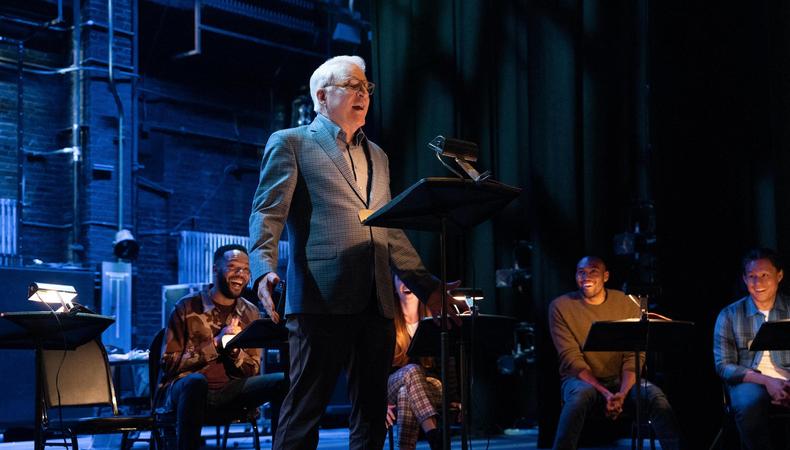
Although they may seem like an artifact of a bygone era, the legacy of patter songs can still be heard today. Like contemporary rap, the patter song is fast-paced and filled with tongue twisters. Here’s everything you need to know to perform a perfect patter.

“Hamilton” Courtesy Lin-Manuel Miranda and Nevis Productions
Patter songs are comedic tongue twisters filled with information. They often serve as emotional breaks in comic operas and musicals. Listen to Gioachino Antonio Rossini’s “La Danza” to get an idea of the frenzied pace of a patter song:
“While they reached heights in the operatic canon...the origins of patter songs go back to at least the 16th century in the Western canon,” explains Paul Chwe MinChul An, a multi-disciplinary musician who has performed at the Metropolitan Opera, LA Opera, and POPera. He adds that the form has long been “a memorable way of either driving the plot forward [or] giving insight to the emotional fray within the scene.”
It’s probably the 19th-century musical duo W.S. Gilbert and Arthur Sullivan with which the form is most closely associated. The duo were masters of the craft, as evidenced by the patter song’s inclusion in projects including “H.M.S. Pinafore,” “The Pirates of Penzance,” and “The Mikado.”
The line “Now I'm the very model of a modern major general” even appears in Lin-Manuel Miranda’s “Hamilton.”
Today, patter songs feel a bit retro, which is likely why Steve Martin’s performance of a patter song during the third season of “Only Murders in the Building” was so well-received:

Kozlik/Shutterstock
Skills required to perform a patter song
Patter songs showcase a set of skills that not all performers have but should always be working towards: namely, timing, comedic chops, and verbal dexterity. These songs are also great if you aren't a more traditional singer—though that always helps—as you don’t necessarily always need to be on key or have a good vocal tone to perform them well.
- Timing: Patter songs can often be “high octane” and “really hard to perform and learn, especially if scansion doesn't track,” An explains. Scansion is how you find the rhythm of a line of verse, usually via the visual graphing of the meter and pattern within the verse or song, to figure out and time the lyrics to the music.
- Comedy: Since patter songs are meant to make the audience laugh, it’s imperative that performers understand humor and physical comedy.
- Verbal dexterity: The tongue-twisting nature of patter songs means that performers must have good vocal control. An upside of this is that learning how to patter provides great exercises for refining one’s diction and clarity across all means and manner of performance, both physical and mental.
Step-by-step guide to performing patter songs
- Do your research: Watch other performances to prepare yourself, paying special attention to each singer’s rhythm, diction, and physical movements.
- Warm up: Whatever warm-up exercises you do vocally, make sure they’re the first thing you do before you sing. Move those muscles, practice some tongue twisters, and perform a speedy speech to ready your voice.
- Practice, practice, practice: If you’re not practicing, you’re doing yourself a disservice. Repetition will make singing a patter song that much easier. Bonus points if you record your sessions for further analysis!
- Work with a vocal coach: Working with a vocal coach or teacher can help you improve your diction, pace, and performance abilities.
Tips for performing patter songs
Analyze the song: If you decide to tackle a patter song, it's important to break down the song into digestible parts, whether that’s story first, words first, or melody first. Whatever you choose, make sure it leads you to a more holistic understanding of the song you’re about to perform. There’s still a story there, after all, and your performance of it needs to make that clear and give the audience a lift. As An puts it, “It's helpful to organize the lines just like one would do with any scene—with arc, accents, [and] pivots.”
Get physical: The physical challenge of these songs cannot be understated. It may seem silly to say it, but it’s true: The more physically fit you feel, the easier it will be to perform a patter song, because the verbal and physical dexterity required can sometimes feel downright acrobatic. Tongue twisters, light cardio, stretching, and facial massages will all make a difference in your ability to endure a patter performance.
An, who is currently acting in a double bill show “filled with patter songs,” says that they make for a very physical evening. “There's one particularly long and difficult one,” he says. “I had a hell of a time learning it, and the director…broke down each line with little physical gestures. First to aid the memory, but they worked so well [story-wise] that we ended up keeping them for the show.”
Keep the rhythm: The rhythm of a patter song should keep both the performer and the audience on their toes. “When the text is set in an awkward way where the natural rhythm of the text is at odds with the notation of rhythm, it can be very difficult,” An says. “They are like speed bumps in a racetrack.”
Knowing what and how a patter song works is crucial for any and all musical theatre artists, whether you’re the writer, director, or performer.
 How To Break Into Musical Theater
How To Break Into Musical Theater 


















